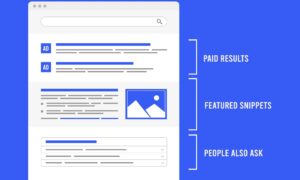
8 Easy SEO tips for higher rankings

If you know anything about SEO, you’ll know that its main purpose is to optimise your website for search engines. In other words, to make it more visible to potential customers. The higher your website appears in SERP rankings, the more likely people are to click on it. With more visitors comes more potential conversions, which leads to more profits for your business and, well, you can work out the rest.
To generate more organic traffic to your website, you need to know which terms people are searching for, and how you can rank higher for them than your competitors. If you want your company to get noticed, SEO should be considered a vital asset to your business.
1. Target low-competition keywords
Competition might be the tool that ignites innovation, but when it comes to keyword research for SEO, you want to focus first on targeting low-competition keywords. These terms (otherwise known as low search volume keywords) have fewer companies competing for them, making them easier for you to rank for – provided that they’re actually relevant to your products and services that is.
Targeting these keywords is great for generating organic traffic- they sit in a perfect balance of being popular enough to generate traffic and searches, but not so popular that every site is competing for them. This way, your site can stand out for a low-competition search and overall boost your ranking.
2. FAQ sections can be used to rank for long-tail keywords – FAQt!
By providing an accessible page on your website that contains all of the information your customers could be looking for, you can improve your site’s rankings for long-tail keywords. These are phrases that normally contain 3-5 keywords which are less competitive than generic keywords because they’re designed to relate directly to people’s search queries.
You can find out common queries by inputting the beginning of a query into Google’s search engine and seeing what results auto-fill produces. Alternatively, you can conduct research on online forums or social media platforms such as Reddit, to understand what people want to know, and how your company can provide the answer.
3. Internal linkings will help boost page authority

Creating internal links between your web pages can help customers navigate your site while you navigate to the top of the SERP rankings. Not only do these links make it easier for Google to understand your website so that it knows where to position it in the search engine results, but they also give your company more evidence of experience and authority.
What’s more, by creating pathways between your site’s web pages by linking clear anchor text with relevant content, customers will be less likely to leave your website, and therefore more likely to convert. In other words, what’s the use in leaving if you’re onto a good thing?
You can use tools like Ahrefs Webmaster Tools. This allows you to crawl your site with Site Audit and identify contextual internal linking opportunities.
4. It’s not about the winning…except when it comes to featured snippets

Google featured snippets are the first piece of information that shows at the top of the page in response to an informational search query – usually a summary of the information a user wants to know. You can improve your rankings by winning featured snippets by matching the query in a H1 or H2 heading in your content, or by restating the question when you answer the question.
Be careful though, as you don’t want your content to sound forced or clunky as you try to wedge in relevant search terms. Instead, you can “win” featured snippets by fully defining the topic, using second-person language, or using a “what is” heading. This will optimise your content to appear higher up in search rankings without sacrificing a natural tone.
As you can see, this featured snippet provides brief information about how, as a “content-first SEO agency”, we can help you improve your SEO through “powerful user-first informative content”. If users can get what they need from your website as a first resort, they’re more likely to build up trust with your brand as an experienced, expert, and authoritative source of information.
5. Align content with search intent

When it comes to creating content that answers the search queries of your target audience, It’s important for SEO that you understand the intent behind the search. By anticipating what your potential customers are looking for and interacting with online, you can react accordingly. This means crafting high-quality content that not only looks impressive, but also clearly delivers the information they want to know, and in a format that’s accessible for their search device.
Search intent-appropriate content, by its very nature, comes in a variety of forms. For example, if you’re appealing to young adults who are chronically online on social media apps such as TikTok or Instagram, you might present your content in the form of a reel. Alternatively, if you’re a marketing company aimed at other businesses who want to improve their visibility online, you might instead present the information in an informational blog post, like this one.
6. Content is king, and it must be comprehensive
Content can always go further, covering a range of subtopics to create a valuable piece. You allow yourself to rank for more search terms and position yourself as an authoritative source for a user to find all the right information. Not only will the user turn to you for answers, but Google will reward you with higher rankings if it sees a user finding your content useful.
After all, it’s Google’s (or any search engine’s) job to display results that satisfy what the user is looking for. If your content hits all the right marks, you boost your ranking opportunities. Using topic clustering can help fill any content gaps and create thorough pages that answer every component of a user’s query.
Refreshing old content is another method to help your rankings. Once you’ve achieved your ranking, it’s not a guarantee that you’ll keep it. There’s a chance that you’ve spotted some content making its way down the SERP, and you’d like to rescue it before it sinks. Locate your underperforming pages, and begin to re-optimise them- this may include fixing technical content issues, adding fresh content, resolving outdated facts, and fixing any broken backlinks.
7. Boost your E-E-A-T signals
E-E-A-T signals, while not a direct ranking factor, fit Google’s content guidelines and prove that you’re a trustworthy source that it can show to users.
E-E-A-T stands for experience, expertise, authority, and trust. This can be demonstrated through:
- Quality backlinks
- Expert quotes
- Author bios
- Citing sources
- Contact details
- High-quality content
These signals tell Google that the content has been crafted for the user and has prioritised helpfulness. This demonstration gives your page another level of quality that distinguishes it from all the other content on the web.
8. Create enticing titles
Your title is often the first thing a user sees in the SERP before deciding to click. It can be the difference between valuable traffic or a missed opportunity.
Check out our guide ‘How to craft great page titles for SEO‘, containing all you need to know about creating an enticing title! Read our expert team’s advice on creating compelling copy for your all-important first impression.
The tips of the iceberg
So there you have it, five useful SEO tips to improve your site’s rankings and increase your rate of conversion. By implementing an effective SEO strategy into your website’s design and analytics, you’re much more likely to generate more organic traffic to your site. While the work doesn’t stop there, getting your website onto the online radar of your intended audience is the first step to SEO success.
If you’re a business looking to optimise your website for maximum visibility and user engagement, why not speak to a member of our team today?